
If you produce your own music at home, then you may already own too many MIDI Controllers for your desk. When you’ve got too many devices to play with just two hands, then you need a MIDI foot controller. They can also be used live onstage to control MIDI devices while playing guitar or keys. Here are the best MIDI foot controllers for home studio or stage use. Want a foot controller that works via USB instead? We’ve got you on that one too.
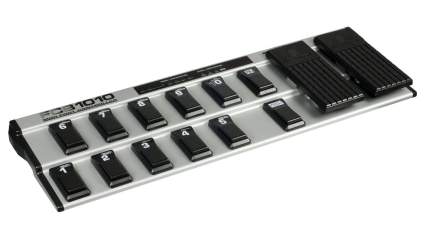
|
Amazon Customer Reviews
|
Price: $159.00 Shop at Amazon | Shop now Read our review |
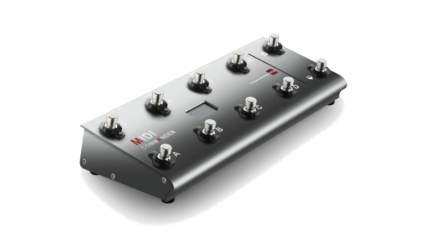
|
Amazon Customer Reviews
|
Price: $139.99 Shop at Amazon | Shop now Read our review |
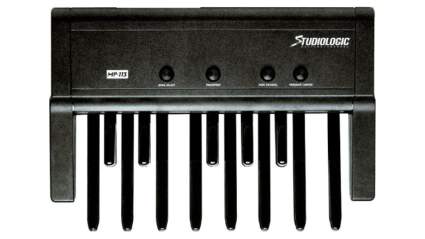
|
Amazon Customer Reviews
|
Price: $799.95 Shop at Amazon | Shop now Read our review |
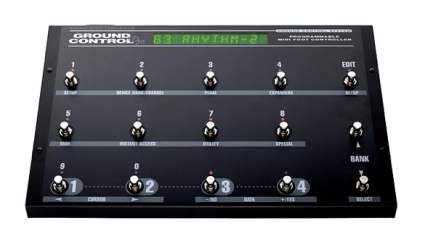
|
Amazon Customer Reviews
|
Price: $449.99 Shop at Amazon | Shop now Read our review |
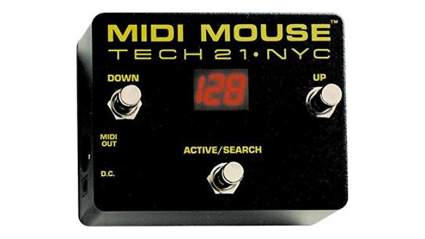
|
Amazon Customer Reviews
|
Price: $119.00 Shop at Amazon | Shop now Read our review |
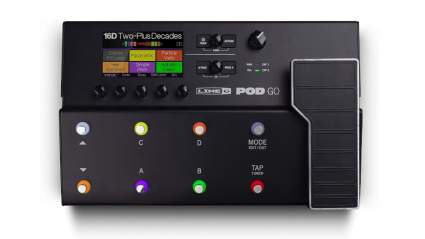
|
Amazon Customer Reviews
|
Price: $499.99 Shop at Amazon | Shop now Read our review |

|
Amazon Customer Reviews
|
Price: $369.00 Shop at Amazon | Shop now Read our review |
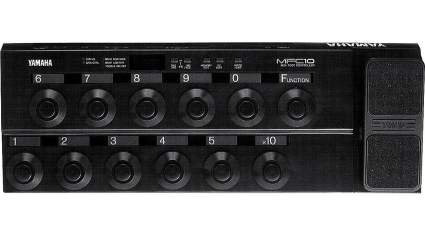
|
Amazon Customer Reviews
|
Price: $321.44 Shop at Amazon | Shop now Read our review |
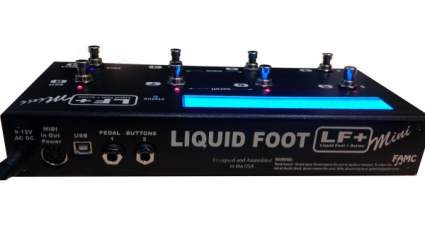
|
|
Price: $349.00 Shop now at famcmusic.com | Shop now Read our review |

|
|
Price: $304.00 Shop now at loopcommunity.com | Shop now Read our review |
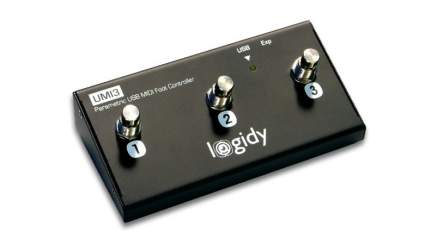
|
Amazon Customer Reviews
|
Price: $99.00 Shop at Amazon | Shop now Read our review |
-
1. EDITOR’S CHOICE: Behringer FCB1010
Pros:- Hefty and durable
- 2 expression pedals and 10 MIDI switches
- 2 programmable switch jacks to cycle through amp presets
Cons:- Not very portable
- 3rd party software required to program
- No MIDI to USB cable included
The Behringer FCB1010 is a versatile MIDI footswitch that is designed to work best for guitar players that use amp modeling software like Guitar Rig.
Its clearly labeled stompbox-style switches are easy to find in the most hectic moments, and the casing is incredibly durable.
With dimensions of 27.1 x 8.7 x 2.4 inches, this controller has a sizable footprint, but it makes good use of its size with a spacious control array. It has two expression pedals and ten switches tied to preset banks.
Each preset bank can hold ten presets, which you can cycle through easily using up and down buttons.
Programming different MIDI functions to these presets can seem overwhelming, but once you scale the initial learning curve, it will feel effortless.
This huge interface comes at the cost of portability. However, given the versatility of this board, it can easily fill the role of several devices in your arsenal.
Imagine having one expression pedal serves as a wah pedal, and having the other serve as a volume rocker.
You can use the rest of the switches to cycle through different channels on your amp using one of two built-in switch jacks, and still, have plenty of controls leftover to assign samples or utility functions.
That said, the device lacks built-in Midi to USB support, so you’ll have to use a MIDI converter like the Roland UM-ONE MK2 to connect it to a computer.
Connecting it to a computer also enables you to use third-party software to remap the FCB1010, but a small alphanumeric LCD display allows you to customize most settings without using a PC.
Although this controller is built to be stage ready and has a built-in power supply, it works just as well as a USB accessory in a bedroom recording setup.
Just make sure you have the floor space for this behemoth pedal board.
-
2. The MeloAudio MIDI Commander Foot Controller
Pros:- 10 MIDI switches plus 2 expression pedal ports
- Backlit display
- 3-way power supply
Cons:- Limited programmability
- Doesn't work as a 5-pin MIDI interface for iOS
- Limited manual documentation
The MeloAudio MIDI Commander is a versatile and portable MIDI controller that works just as well in the studio as it does on the stage. You can plug it in and immediately switch to one of eight host presets or you can set up two custom modes for PC or CC commands.
The host presets support JamUp, Bias Fx, AXE FX, KPA, ATOM, and PC-8x. It has plenty of connectors so you can hook it up to an effects rig, a PC, a Mac, or an iOS device.
Between the MIDI Commander’s USB-out port and 5-pin MIDI port, all of these are accessible with the right cables. When connecting to an iOS device via an Apple OTG cable, the MIDI Commander can be a little glitchy, but otherwise, it works fine. It cannot connect to iOS devices via 5-pin connector.
The custom PC and CC modes are nice too, although they aren’t very sophisticated. For example, you can’t set this pedal to MIDI note mode. Instead, it sends a constant CC signal, which makes it hard to use certain plugins like Ableton Live’s Looper. You also can’t set incremental program changes. Those who need a highly customizable MIDI foot controller should look elsewhere.
To further add to its versatility, the MIDI Commander has three different power supply options, the most convenient of which is two AAA batteries, which supports up to 40 hours of use. This device can also be powered by a USB pass-through cable or an OTG USB cable.
As for the device itself, the MIDI Commander is quite well built. It is fairly compact at only 12.6 x 5.2 x 3.6 inches, yet it also feels durable enough for stage use.
The device has 10 foot pedals, which have plenty of space in between for you to add labels. The device has two 1/4-inch expression pedal jacks, so guitar players can mix wah or volume control into their signal.
The MIDI Commander has a backlit OLED screen, which is small but easy to read from any angle. It is useful for displaying USB-MIDI state, battery state, PC#, CC#, or the levels of each expression pedal.
If you need a MIDI foot controller that does it all, the MIDI Commander is a great pick. Its jack-of-all-trades design will make it a lasting addition to your pedal selection.
Find more The MeloAudio MIDI Commander Foot Controller information and reviews here.
-
3. Studiologic MP-117 Dynamic MIDI Pedal Board
Pros:- 17 velocity-sensitive wood tipped pedals
- Analog controls for Program, Bank, Channel, and Transposition
- Hefty and durable
Cons:- High price tag
- Not very portable
- No MIDI to USB cable included
The Studiologic MP-117 (also sold as the Fatar MP-117) is a MIDI controller with the build quality, heft, and price tag of a legit keyboard.
In many ways it is. The only thing stopping this foot controller from being its own instrument is that it demands your input.
The MP-117 adds a lot of bulk to your setup at 18.2 pounds and 24 x 16.5 x 5.9 inches, but this controller allows you to play on organ bass pedals no matter what your upper body is doing.
The controller’s seventeen velocity-sensitive pedals can be programmed to whatever you’d like, but they exceed at allowing you to play melodies with your feet.
The pedals are wood tipped and have the expert craftsmanship to suggest that they were pulled straight from a church organ.
Musician Tyrone Douglas shows off a minimalist example of how the MP-117 can be used to lay down bass lines over a lead instrument.
Above the pedals are solid analog controls to select MIDI bank, Transpose notes, change MIDI channels, and to change MIDI program.
You might already have some of these controls on a different interface, but this leaves little else you can ask for, aside from a power switch.
Since the MP-117 is primarily designed to plug into a keyboard, it does not include Midi to USB support out of the box.
This can easily be remedied, but it is an annoyance to have to buy a MIDI box on top of the Studiologic’s massive price tag.
Find more Studiologic MP-117 Dynamic MIDI Pedal Board information and reviews here.
-
4. Voodoo Lab Ground Control Pro MIDI Foot Controller
Pros:- Large backlit alphanumeric display
- 8+ programmable MIDI switches
- Sturdy and durable
Cons:- No MIDI to USB cable included
- Limited manual documentation
- Not very portable
Voodoo Lab’s Ground Control Pro offers tour-ready build quality at a middle-of-the-road price, making it a hard deal to pass up for gear enthusiasts. The pedal has a footprint of 17 x 11 x 2.5 inches, making it a nice middle of the road size, especially considering the versatility it offers.
The GC Pro has eight programmable switches, among seven additional switches which can be used to swap MIDI banks and navigate the menu on the GC Pro’s illuminated alphanumeric display.
All of this can be daunting to a newcomer, especially with the manual’s limited documentation, but it gets easier if you offload some of the difficulty to a DAW you are familiar with.
The GC Pro doesn’t have MIDI to USB connection by default, but with a separate MIDI adapter, you can use your favorite audio programming software without much trouble.
You can pair the GC Pro with other hardware as well, as it has two pedal inputs, plus MIDI I/O ports. Voodoo Lab even makes a suite of complementary products designed to go with it.
The most useful complementary product is the GCX Guitar Audio Switcher, which allows your GC Pro to be used to control different amp settings on MIDI-compatible amps.
For the casual audio enthusiast, the GC Pro is a budget breaker, but you won’t find a piece of equipment at this quality for cheaper. They’re easy enough to come by used as well.
Find more Voodoo Lab Ground Control Pro MIDI Foot Controller information and reviews here.
-
5. Tech 21 MIDI Mouse
Pros:- LED screen for easy MIDI channel selection
- Compact and simple design
- Low price tag
Cons:- Small switches could be larger
- All channels are on one bank
- No MIDI to USB cable included
The MIDI Mouse is a small MIDI foot controller with three switches. Like the UMI3, its design philosophy is decidedly minimalist. What sets it apart from other budget MIDI foot controllers is its backlit LED display and small form factor.
This sturdy and lightweight controller measures out at a modest 4.8 x 3.8 x 2 inches and keeps the interface simple with just three switches. These metal switches are high quality and are fairly quiet when used.
Two have the dedicated function of cycling through sixteen different MIDI channels, which can store a collective total of 128 patches. The center button allows you to toggle between browsing and selecting your MIDI channel.
This is all stored in one MIDI bank, which can be troubling if you have a lot of active channels that need to be organized into groups. If this is the case, you can also consider its big brother, the MIDI Moose.
You can remap these buttons to perform other tasks if you really need to, but if you aren’t primarily going to use this stompbox as a MIDI channel selector, then you might as well forgo the LED screen for the slightly cheaper UMI3.
The MIDI Mouse receives phantom power via MIDI, though you can also plug in a DC adapter or 9V battery if your keyboard doesn’t deliver phantom power.
Overall, the MIDI Mouse is so good at what it does, that I can’t really imagine it doing anything else. It should be the go-to option for a simple channel selector. There is technically no such thing as a plug-and-play MIDI controller, the MIDI Mouse is about as close as it gets.
Find more Tech 21 MIDI Mouse information and reviews here.
-
6. Line 6 POD Go
Pros:- Backlit LED display
- Four MIDI bank buttons and other dedicated controls
- Plug-and-play with Line 6 amps
Cons:- Noisy switches
- No MIDI port
- Not very portable
The Line 6 POD Go is another hefty guitar-oriented footboard, which boasts a surprising amount of versatility thanks to ample switches and inputs. The FBV 3 has a 1/4-inch expression pedal jack, an RJ-45 jack to connect with compatible Line 6 amps, and a USB port that can be used to send MIDI data.
An actual MIDI port is absent from this controller, so it can’t be used with synths or other MIDI instruments. However, you can use a third-party software to reprogram it for use with a DAW.
When you are using the Shortboard with a compatible amp like the Spider IV, it is programmed to be plug-and-play. You can tap tempo, toggle reverb, delay, and pitch modulation without any programming.
The backlit LED display shows you which MIDI channels are active when connected, but won’t always work as easily when being used as a generic MIDI controller.
Looking at the board itself, it has thirteen switches total, but only four store MIDI presets to a total of 64. It also has a solid expression pedal, which can be generically programmed just as easily as the switches. The FBV 3’s switches are made from steel and are quite clicky. They are large and well-spaced, allowing them to fill out the case’s dimensions of 18.1 x 9 x 3 inches.
If the Shortboard doesn’t feel short enough, you can also opt for the Line 6 FVB Express, which is a four-button version of the same controller. Both Line 6 FBV controllers are well-rounded products, but without a MIDI port, it raises an important question: do they still count as a MIDI controller? As long as you are using it via USB, the answer is yes.
Find more Line 6 FBV Shortboard MkII Foot Controller information and reviews here.
-
7. SoftStep 2 USB MIDI Foot Controller
Pros:- 10 pressure and direction sensitive pads
- Backlit switches and LED screen
- USB-powered
- Lightweight and durable
Cons:- Editing software has a high difficulty curve
- No MIDI port
- Board slides on carpeted surfaces
The SoftStep 2 from Keith McMillen Instruments might look like a Dance Dance Revolution pad from another dimension, but don’t be confused. It is actually one of the most versatile USB controllers out there.
This full-size pedalboard is made from lightweight yet rugged elastomeric and graphite composites, and measures out at 17.5 x 4.2 x 1 inches. Its only shortcoming is a lack of grip, as it will slide easily on carpeted surfaces.
The design is far lighter than solid metal units like the FCB1010 and Ground Control Pro, yet the SoftStep can resist spills and survive being driven over.
The SoftStep 2 has ten gesture-sensitive pads that register both pressure and position. This allows you to send up to six messages per key, including notes, CCs, program change, MMC, and OSC messages.
The board is fully backlit from its switches to its LED alphanumeric display, and the LEDs can change color to designate which CCs are toggled. There is a larger D-pad to the right for navigation.
These switches can all be programmed using either the Basic or Advanced SoftStep Editor, both of which are free on the Keith McMillen website.
The basic editor has a steep learning curve if you are new to MIDI programming, and the advanced editing software is almost impossible.
But once you get the hang of it, you’ll be astounded at how much this controller is capable of.
The SoftStep2 is mind-blowingly diverse, and save for the fact that it does not have an analog MIDI port, I would say you could use it for just about anything.
Find more SoftStep 2 USB MIDI Foot Controller information and reviews here.
-
8. Yamaha MFC10 MIDI Foot Controller
Pros:- 10 MIDI switches plus an expression pedal
- Supports up to 100 control changes and 128 program changes
- Pre-programmed for select Yamaha keyboards
Cons:- No MIDI to USB cable included
- Limited manual documentation
- Not very portable
The Yamaha MFC10 is yet another foot controller designed for use with a specific instrument. But despite its price being set by this compatibility, it still stands to impress as a generic MIDI controller.
This foot controller is pre-programmed for use with Yamaha keyboards like the WX5 and TYROS 3 and 4, but aside from this difference, is very similar to the FCB1010.
Both have an expression pedal (the FCB1010 has two), and both have ten switches which can access presets across different banks. Both are also rather hefty.
The MFC10 has dimensions of 24 x 6.1 x 8.5 inches and is certainly a tough one to carry around.
Aside from four 1/4-inch expression pedal jacks, the only other connections on the MFC10 are a MIDI I/O and a WX-in jack for connection to a WX5.
It does not come with a built-in USB port or MIDI to USB cable, meaning you’ll need to add one to your shopping list if you want to use this as a PC MIDI controller.
But it can be used to automate a number of effects and sequences, helping you streamline your setup onstage or at home.
Its internal software can support up to 100 control changes and 128 program changes. Of course, it can also send MIDI notes as well.
Basically, anything a generic controller like the FCB1010 can do, the MFC10 can do just as well. As long as you don’t mind the slightly higher price and equally bulky layout, this controller will work for a whole world of uses.
Find more Yamaha MFC10 MIDI Foot Controller information and reviews here.
-
9. FAMC Liquid Foot+ Mini
Price: $349.00Pros:- 8+ silent MIDI switches with LEDs
- Large backlit alphanumeric display
- Free programming software
Cons:- Small switches could be larger
- High price tag
- Hard to find
The Liquid Foot+ Mini is a top of the line foot controller from FAMC that offers plenty of utility in a modestly-sized package. The LF+ is only 11 x 5 x 1.7 inches and about 2 pounds.
In terms of connectivity, the LF+ has a MIDI out port, a MIDI-to-USB port, and two 1/4-inch expression pedal jacks, so connecting to any system is no problem.
It has eight switches, each with a seven color LED, and each more silent than any other board out there. The switches are small, but well-spaced and have a lifetime guarantee, ensuring you can stomp as hard as you want.
When connected via USB, you can use the free LF+ Software Editor for Mac and PC to design up to fifty different layouts so you can switch musical scenes on the fly.
The controller has a handy backlit LED screen, which helps immensely when navigating the massive number of storable presets.
This controller receives phantom power from MIDI or USB, but if needed, you can attach a DC power adapter (not included).
Thanks to its quality construction and generous selection of inputs, the Liquid Foot+ Mini will work a great number of setups and is constantly recommended across some of the most reputable gear sites out there.
Find more FAMC Liquid Foot+ Mini information and reviews here.
-
10. Looptimus USB MIDI Foot Controller
Price: $304.00Pros:- Convenient controller modes for MIDI notes, programming, and pads
- Lightweight and durable
- Backlit LED screen
Cons:- Navigation switches could be better spaced
- Buttons click loudly
- Hard to find
The Looptimus USB MIDI Foot Controller is an easy to use foot controller that sits in a durable powder-coated aluminum case. It is modestly sized at 10.3 x 7.7 x 4.7 inches.
Its layout offers six well-spaced switches to control MIDI notes, or program changes, or MIDI pads. There are also three other switches, two of which are dedicated to navigating through the twenty banks, and the final being a stop button.
The navigation switches are a little too clustered together, but the handy backlit LED display will help ensure you don’t accidentally select the wrong bank.
This controller sets itself apart with convenient play modes that help keep each button’s multiple functions distinct for those newer to MIDI controllers.
The MIDI Note Mode allows you to send MIDI notes to a DAW, which can be used to trigger songs or contribute some ambiance.
The Program Change Mode can be used to cycle through preset effects on a MIDI-compatible instrument while simultaneously triggering your next song.
And the Pad Mode is an easy way to convert the six bank switches into the corresponding chords in your choice of key and octave.
The Looptimus could practically be an instrument on its own, yet its great connectivity means it never has to. This compact device has a MIDI out port, a MIDI-to-USB port, and two 1/4-inch expression pedal jacks.
It receives phantom power from USB, but can also be powered by a DC adapter if needed. If you are keen on the idea of having interchangeable modes to manage your different MIDI endeavors, then the Looptimus is a solid pick.
Find more Looptimus USB MIDI Foot Controller information and reviews here.
-
11. Logidy UMI3 MIDI over USB Foot Controller
Pros:- Simple and durable design
- USB-powered
- Free programming software
Cons:- Small switches could be larger
- Lacks MIDI in/out for expansion
- Few switches
If the FCB1010 just seems like absolute overkill for your needs, the simple Logidy UMI3 is a good alternative. It has just three buttons, making it the definitive programmable MIDI foot controller.
Its small and simply labeled switches are all easy to access atop a durable steel case. The UMI3 does have an input to add an expression pedal if your needs expand over time.
The UMI3 is meant to be used with a PC or digital workstation, and therefore conveniently draws its power from USB. This also means that there is no way to program this controller outside of plugging it into a device.
That is not to say that the three-button setup is particularly limiting, either, as it is easy to assign useful tasks to the UMI3’s buttons on any DAW.
For example, many users assign start, stop, and record functions to assist with recording multiple instruments takes in Ableton and Logic Pro.
The only thing you would need the additional (free) Logidy Full Circle configuration software for would be to send several different MIDI commands when a button is pressed.
As for the device itself, the three metal buttons are well-built and are fairly silent when pressed down.
The case’s total dimensions being 6.7 x 4.3 x 2.3 inches. This means that those with larger feet may have trouble accurately stomping the buttons. But the UMI3’s simple layout really helps leverage this issue.
The lack of additional MIDI in/out ports means that this controller cannot be daisy-chained with others, which would be a really nice touch.
But alas, if you think you’ll need even a few more controls, you’re better off upgrading to a slightly larger controller.
Find more Logidy UMI3 MIDI over USB Foot Controller information and reviews here.
Mastering the MIDI Foot Controller
MIDI foot controllers are incredibly useful in the home studio but they can also be the missing piece to your live performance. A conveniently-placed MIDI foot pedal box can be just what you need when you're already using both hands playing guitar or a keyboard. The hardest part is figuring out how to harness its potential.
Like most MIDI-to-USB peripherals, you can program these interfaces to do just about anything. The options are nearly limitless. You can map a whole board of switches to key utilities like tap tempo, FX toggling, and play/pause/record. Alternatively, you can map each control to a music note and play it like a foot-powered instrument.
If you are feeling intimidated by the process, you can follow this brief MIDI guide from Premiere Guitar to get caught up on basic MIDI terminology and applications. Once you understand the basics you are only a brief Google search away from putting your MIDI controller to loads of useful applications.
How to Pick the Best MIDI Footswitch For Your Needs
If you are having trouble selecting a MIDI controller then you should try picking an end-goal you wish to reach and then working backward from there.
If you have a specific use in mind like being able to switch your guitar channels or trigger pre-recorded clips, then you can use that scenario to figure out the specifics of your dream device.
For instance, how many switches do you need? Do you have enough room for a board with that many switches? Even more importantly, what inputs and outputs do you need besides MIDI? Those connecting to a guitar amp or keyboard may want a 1/4-inch jack to chain in pedals.
And while looking at the specs is of great use, going hands-on (or feet-on) is the most important aspect of finding the right MIDI controller for your needs. If, however, that option isn't available to you, we've got you covered.
See Also
10 Best DAC Amp Combos Under $300: Your Buyer’s Guide